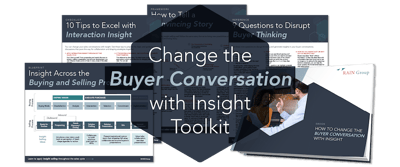The world of B2B selling looks far different than it once did. Top sellers know they must go well beyond discussing features and benefits. They need to be closely tuned in to the buying process for each member of the buying committee while consistently meeting buyers where they are throughout the cycle.
That’s a tall ask, as it turns out. According to Gartner, as many as ten decision makers might make up a B2B buying center. Additional data from CMO Council shows that B2B customers actively research and compare solutions, often completing 50% to 90% of the work before contacting a sales rep.
Long story short: complexity is a hallmark of B2B sales.
A Harvard Business Review Analytic Services survey in March 2022 found “New/changing buyer demands and expectations” to be the top sales effort challenge, cited by 43% of respondents (34% cite “Difficulty engaging buyers virtually”).
The struggle is real. Fortunately, there’s a path for B2B sellers to meet this challenge.
The 9 Advanced Consultative Selling Skills for B2B
Advanced consultative selling skills comprise what we call insight selling, a framework that positively correlates with top performance. Top Performers have higher win rates on proposed sales and achieve premium pricing.
Our research on The Top-Performing Seller found that sellers who excel in the following advanced consultative selling skills are 94% more likely to be Top Performers. If you like those odds, you’ll want to pay attention to these 9 skills.
- Inspire confidence and succeed with executive-level buyers
- Inspire buyers to reach out for ideas and advice
- Influence buyer thinking about the solutions they need
- Educate buyers with new perspectives about what they should do or buy
- Make and communicate strong financial cases for buyers
- Find and capitalize on cross-sell/upsell opportunities
- Collaborate deeply with buyers throughout the buying process
- Develop buyer champions to advocate for the sale
- Lead highly effective proposal and finalist presentations
1. Inspire confidence and succeed with executive-level buyers
Finding time with executives can feel like chasing the fabled unicorn. However, the ability to connect with executives and cultivate their trust and confidence is critical to closing complex deals. It’s not easy, especially when dealing with skeptical executives, who are often slow to move forward or greenlight a big-ticket deal.
Still, there are ways for sellers to maximize the time they get with executives, and to deepen those relationships along the path to closed-won:
- Be humble and respectful, but don’t play the inferior
- Leave any personal hang-ups at the door
- Bring big ideas to the table that go beyond solving problems
- Find interpersonal resonance and develop rapport
- Conduct meaningful and productive conversations
- Don’t give up in the face of adversity
- Build an impeccable personal brand
2. Inspire buyers to reach out for ideas and advice
The best sellers are prepared to share ideas and advice with buyers. Though they may make it seem effortless, these sellers invest time to develop personalized, high-value ideas for buyers.
Indeed, buyers are looking for this. In our sales prospecting research, 71% of buyers tell us they want to connect with sellers early in the buying process when they’re looking for new ideas and possibilities.
To influence them to do so, sales reps can start by sharing primary research relevant to the buyer’s business (cited by 69% of buyers as influential). Buyers also want to see content customized to their specific business situation (67%), insight on solutions to business problems (66%), and best practices (65%).
Ultimately, connecting with buyers early comes down to two core tactics:
- Reach out to buyers proactively (82% of buyers accept meetings with sellers who reach out)
- Build attraction campaigns around strong value-based offers that entice buyers to connect
3. Influence buyer thinking about the solutions they need
Many inexperienced sellers find themselves staring at dead ends for a simple reason: they don’t know how to reframe the solution for buyers. They struggle to cast the solution in a new light that the buyer might not have considered.
The first step is to disrupt the buyer’s existing thinking. The idea is to shake them out of their comfort zone by showing them that the path they’re on won’t work, despite what they’ve already invested in it. Often, sellers can disrupt just by asking the right questions (for example, “What if you don’t do X, Y, or Z in the next two years and your closest competitor moves past you?”).
The next step is to reframe the discussion. Encourage buyers to rethink their situation and problems—existing or soon to arrive (“What if there is another solution outside of what you’ve considered?”).
Finally, direct the buyer toward a better outcome. A classic example of this powerful form of advocacy is telling the success story of a similar buyer. For example, “Another client in your industry faced similar issues. Once they opened up to a previously unconsidered solution, they cut service costs by 10%.”
To influence buyer thinking, remember: disrupt, reframe, redirect.
4. Educate buyers with new perspectives about what they should do or buy
A seller who can educate buyers stands to create tremendous value throughout the relationship. For example, a buyer near the top of the sales funnel may be unaware that another solution to their problem even exists. Farther down the funnel, buyers might need help from sellers to tailor a business case or work through an obstacle during negotiations.
Sellers who can lead buyers to new information and ideas tend to win more. We found that providers who win are 3x more likely to educate buyers with new ideas or perspectives compared to sellers who come in second place.
5. Make and communicate strong financial cases for buyers
What does a strong ROI case really look like? In B2B sales, the answer isn't so straightforward. For one thing, B2B buyers need to see more than a “hard data” financial impact statement. They need to see a realistic path to achieving similar results within the constraints of their organization.
The ROI numbers that buyers see should align with their actual needs. Sure, you claim you can save the buyer a quarter million in customer service costs a year, but the gap they need to close might actually be in the multi-millions, rendering your ROI statement moot.
To begin uncovering this level of alignment around ROI, start with these 7 Questions to Uncover Impact and ROI.
6. Find and capitalize on cross-sell/upsell opportunities
As important as it is to sign new customers, each one comes at a significant price tag. The best sellers know how to spot opportunities within existing accounts to grow and expand. They also know how to avoid the pitfalls of attempting to cross-sell/upsell when the timing is wrong or the offer doesn’t add mutual value.
Having a solid account growth plan and strong planning process are the tools that help sellers succeed here. For example, an account growth plan addresses questions including:
- What are the trends affecting this account?
- What needs does the account have?
- What other insights do we know about this account?
- Who are our competitors?
- What value can we offer?
Learn more about growing key accounts. >>
7. Collaborate deeply with buyers throughout the buying process
Sellers with advanced consultative selling skills know how to work with buyers as a team. That might mean collaborating on a creative solution or anticipating needs and showing up with the right information, data, and support.
This isn’t something that comes naturally to many sellers. For example, professionals at one firm transforming from traditional accounting to an advisory firm struggled with having conversations centered around collaborative insights.
Team members with strong technical abilities frequently defaulted to conversations focused on services rather than how they could work to solve a problem or make the buyer’s business more profitable.
But effective training in advanced selling skills can make all the difference for sellers. For the firm above, it meant double-digit growth in engagement size and year-over-year growth in Net Promoter Score.
Read the complete client success story here. >>
8. Develop buyer champions to advocate for the sale
Sellers are better positioned to close deals when they have a champion on the buying team. The best sellers know this: they’re 57% more likely to proactively develop champions. A champion will advocate for a seller’s solution even when the seller isn’t there. They’ll push the deal forward and even field objections. The trick is understanding how to find champions and establish a strong relationship.
The champion is one of five decision roles in every sale. A champion might burst from the woodwork without prompting if they’re already sold on the solution. The more likely scenario is that sellers will have to find and groom champions on their own. Often, the best way to do this is to simply ask your contacts at the company, “Is there anyone else who might like to see this happen?”
9. Lead highly effective proposal and finalist presentations
Sellers often make three mistakes that torpedo B2B sales proposals: sending the proposal too early, giving in to the lure of the RFP, and/or sending proposals for big deals that aren’t necessarily the best fit. Then, of course, there’s the presentation itself, which sellers can nail if they follow a few best practices.
To start, prepare by identifying the players, asking about logistics, and making sure strategy is on point. Also, present like a champ by building rapport, inviting participation, and sharing stories.
For a full list of best practices, check out 13 Tips to Master Your Next Proposal Presentation.
Advanced B2B Selling Skills: Firmly Within Reach

If our list of advanced consultative selling skills is any indication, the path forward isn’t easy. But the data suggests some good news: developing advanced selling skills pays dividends. To learn more about how RAIN Group helps organizations develop their sales reps’ advanced selling skills, check out Insight Selling, our advanced consultative selling program.






